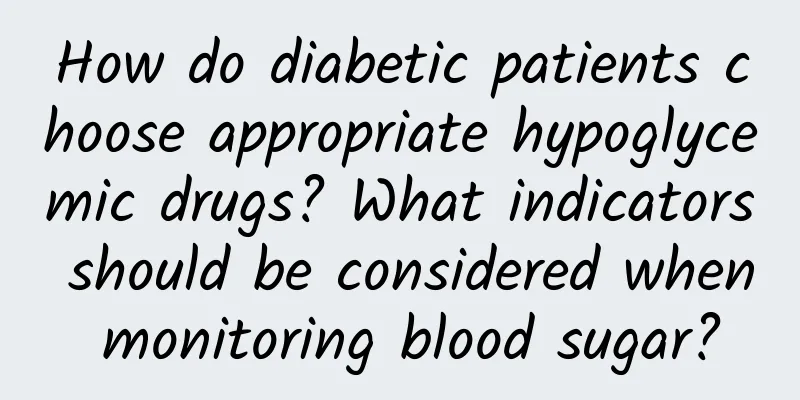How do diabetic patients choose appropriate hypoglycemic drugs? What indicators should be considered when monitoring blood sugar?

|
Author: Li Guangwei, Chief Physician, Fuwai Hospital, Chinese Academy of Medical Sciences Reviewer: Wu Xueyan, Chief Physician, Peking Union Medical College Hospital As a common chronic disease, there is currently no cure for diabetes, but blood sugar can be controlled through a variety of means, and there may even be a "honeymoon period" of several years without the need to take blood sugar-lowering drugs, thereby preventing or reducing the occurrence of complications in important organs such as the heart, brain, kidneys, and eyes. The treatment of diabetes is comprehensive, which mainly includes five aspects: health education, medical nutrition therapy, exercise therapy, drug therapy, and blood sugar monitoring, which are often referred to as the five horses. Figure 1 Original copyright image, no permission to reprint For diabetes, lifestyle intervention is the most important. If the blood sugar level is not particularly high after being diagnosed with diabetes, intervention should be started with diet and exercise to develop a reasonable plan. Blood sugar should be monitored after three months of lifestyle management. If the blood sugar level is within the standard, no additional medication is needed. If it is not within the standard, and the doctor considers that additional medication is needed after evaluation, the medication should be taken as prescribed by the doctor. Current drug treatments for diabetes include oral hypoglycemic drugs and insulin injections. There are many types of hypoglycemic drugs. There is no absolute good or bad drug. The evaluation of drugs mainly includes four aspects: first, efficacy; second, safety (adverse reactions); third, price; fourth, whether it is convenient to take. These four aspects are the basic indicators for evaluating whether the drug is suitable. The pros and cons need to be weighed. Some may pay more attention to safety, while others may pay more attention to efficacy, especially for those with cardiovascular and renal complications. Efficacy is important for all patients, but safety should be given priority in elderly patients. Then there is convenience and price. Therefore, for different diabetic patients, doctors need to guide the selection of hypoglycemic drugs according to their specific conditions and personal circumstances. This is precision treatment. The same drug is good for person A, but may not be good for person B. Therefore, we emphasize here that you must choose it under the guidance of a doctor and let the doctor make a comprehensive judgment on whether this drug is suitable for you. You cannot choose hypoglycemic drugs at will. Doctors need to consider many factors when prescribing medicine for patients. First of all, according to the blood sugar situation, if the fasting blood sugar and postprandial blood sugar values are particularly high, it may be necessary to choose drugs with stronger blood sugar-lowering effects; if the blood sugar is slightly higher, it is sufficient to choose drugs with weaker blood sugar-lowering effects. In addition, some diabetic patients are obese and overweight. If their pancreatic islet function is still good, they can choose hypoglycemic drugs that can not only reduce weight but also do not rely on insulin. Some diabetic patients have poor liver and kidney function. They should choose hypoglycemic drugs that are not excreted by the liver and kidneys. Drugs with evidence of protecting heart and kidney function should at least not add burden to the kidneys and liver. There is also the issue of price. Some patients cannot afford more expensive hypoglycemic drugs, so they have to choose a relatively cheap and effective one. When diabetes is first diagnosed, blood sugar is particularly high, for example, glycosylated hemoglobin is above 9% and fasting blood sugar is above 11mmol/L. The doctor may recommend direct insulin injection and short-term use of insulin to lower blood sugar. After blood sugar is lowered, pancreatic function will recover faster. Let's take a common example. If your house is flooded, everyone knows that the sooner the water is drained, the better. The longer the house is flooded, the easier it is to rot. The same is true for blood sugar. After a sudden rise in blood sugar, the faster it is controlled, the faster the pancreatic function will recover. If it is not controlled early, and delayed for three to five years, the possibility of pancreatic function recovery is unlikely. It should be emphasized that oral medication is the first choice for treatment according to different blood sugar conditions. If one drug cannot bring blood sugar to the standard, two drugs can be used. If two drugs are not enough, three or more drugs can be used. If it still does not work, insulin or oral medication combined with insulin treatment is needed, or even new anti-diabetic drugs that can effectively lower blood sugar and lose weight are needed. For diabetic patients, it is important to monitor blood sugar levels. To monitor whether blood sugar is well controlled, we generally look at three indicators, namely glycosylated hemoglobin, fasting blood sugar, and blood sugar 2 hours after a meal. Glycated hemoglobin represents the average level of blood sugar control for three months and is a relatively stable indicator. When glycated hemoglobin is within the normal range, it means that the blood sugar level has been relatively stable in the past three months. If blood sugar is within the normal range 2 hours after a meal, it means that blood sugar fluctuations are small and blood sugar after a meal is under control, indicating that the blood sugar curve is relatively stable. If fasting blood sugar is 5mmol/L and postprandial blood sugar is 18mmol/L, the blood sugar fluctuation is too large. The greater the blood sugar fluctuation, the greater the harm to the human body. Therefore, when controlling blood sugar, each point has standards and requirements. If each point is controlled within the normal range, it means that blood sugar is under control. With the development of medical technology, the means of blood sugar monitoring are becoming more and more advanced. At present, there is a dynamic blood sugar monitoring system. The blood sugar probe is installed in the subcutaneous fat tissue and is transmitted to the remote control or control device via radio signals, which can display the blood sugar value at any time. Figure 2 Original copyright image, no permission to reprint Some of these dynamic blood glucose monitoring systems can display blood glucose values once a minute, and some can display blood glucose values once every 5 or 15 minutes. Some can monitor continuously for 3 days, and some can monitor continuously for 1-2 weeks, or even 1 month. You can see the high and low blood glucose values in each time period, and know how blood glucose is affected in different situations. For example, if you find that eating this kind of food will increase blood glucose, you will not eat it or eat less in the future; if you go out for a walk, your blood glucose level will drop, and you can understand how blood glucose changes under different living conditions. This device can draw a curve of blood glucose changes over 24 hours, and can monitor blood glucose more accurately. |
<<: There are 8 main manifestations of manic episodes. Do you know?
>>: Will I definitely get cervical cancer if I’m infected with HPV?
Recommend
Causes of recurrent vaginitis
For women, they all want their reproductive syste...
What are the indications for cesarean section?
Cesarean section is a method of delivery in which...
How much is Rosen Basque cheesecake? Is Rosen Basque cheesecake delicious? How does it taste?
As we all know, Lawson is a popular convenience s...
Breast nipple pain
Breast nipple pain mainly occurs during menstruat...
Is NT a Down syndrome screening test?
Whenever a woman becomes pregnant, she has to und...
The standard of top-hip length in three months of pregnancy
The fetal top-to-butt diameter is the length from...
How many days is normal for a woman to have her period?
The first time a woman has her period is called m...
Popular Science | Abdominal massage can prevent constipation, are you doing it right?
Constipation is one of the most common complicati...
What are the symptoms of an open cervix?
The opening of the cervix is actually also call...
Airprox: 117 drone incidents in the UK in 2018
After 36 hours of chaos, Gatwick Airport's ru...
The dangers of vaginal bleeding in early pregnancy
Many women will find that they suddenly have vagi...
One month pregnant, bloating
Every mother is noble and difficult during pregna...
What kind of Dendrobium candidum is good to choose? What should I pay attention to when choosing Dendrobium candidum?
Dendrobium candidum is a kind of green potted pla...
How many days before menstruation can't I take a urine test?
When you go to the hospital for a physical examin...


![[Doctors Talk About Medicine] Warning signs of infectious diseases: Be alert to these symptoms](/upload/images/67f0a7b850c97.webp)






